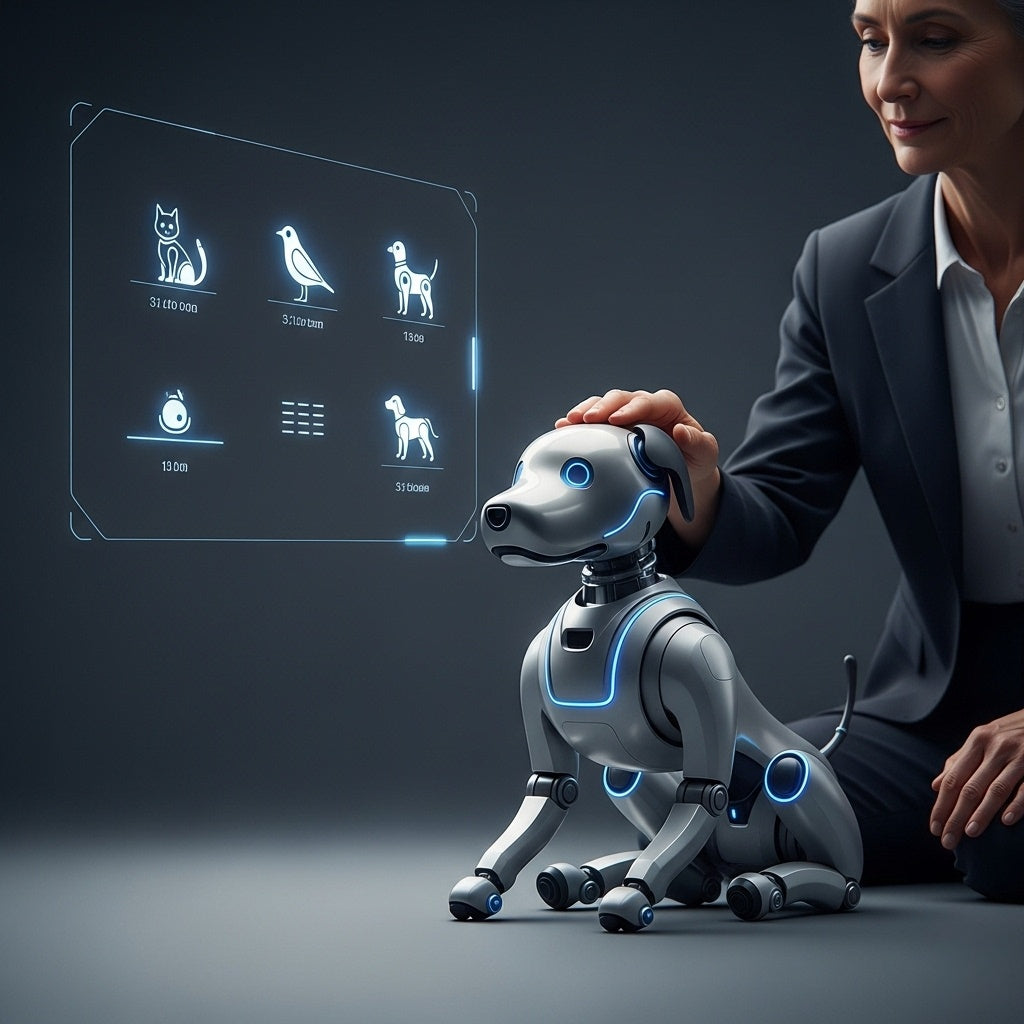Robotic pets for seniors are a helpful solution to loneliness. Most basic models under $200 provide the best value. They can reduce anxiety, increase mood, and encourage social interaction, Success depends on the individual and the robotic companion. Advanced versions are well-suited for specific uses, including dementia care.
Key Points
-
Benefits for Elderly Users: Robotic pets mimic real animals through sound, motion, and feeling. They reduce loneliness and provide comfort. They improve mental health but can not replace human or live pet contact.
-
Affordability Focus: Affordable choices from $40 to $200. Pricey versions (above $400) have smarter AI and greater features.
-
Popular Choices: Robotic dogs, such as Joy for All Golden Pup, are realistic and simple to use. The same brand's robotic cats have calming purrs and motions.
-
Probable Drawbacks: Some seniors may regard them as toys at first. Batteries need occasional replacement. Experts note they should support, not substitute, real companionship.
-
Buying Advice: Choose models with long battery life, sensitive sensors, and hypoallergenic fur. Read reviews from other older adults for helpful insights.
Top Recommendations
-
Joy for All Companion Pet Dog: Around $180, interactive with barks and tail wags. Great for daily companionship.
-
Joy for All Companion Pet Cat: Around $160, purrs on touch. Ideal for cat lovers.
-
Tombot Puppy: About $450-$500, AI-driven for dementia care. More lifelike but pricier.
-
MetaCat Robotic Cat: $159, soft fur and movements. Good mid-range option.
Quick Comparison
|
Product
|
Price Range
|
Key Features
|
Best For
|
|
Joy for All Dog
|
$180
|
Barkback tech, touch sensors
|
General companionship
|
|
Joy for All Cat
|
$160
|
Vibrapurr, realistic fur
|
Calming therapy
|
|
Tombot Puppy
|
$400-500
|
AI learning, health monitoring
|
Dementia support
|
|
MetaCat
|
$150-160
|
Interactive purrs, soft design
|
Budget realism
|
For more details, see the full guide below.
In an era where many older adults live alone, robotic pets offer meaningful connection. These companions provide comfort without any daily upkeep, like feeding or vet bills. As someone who tests and reviews these companions, I’ve created this guide to highlight realistic and practical options that are also affordable.
We'll explore buying tips, dive into product recommendations with honest reviews, and highlight how these companion robotic pets for the elderly can enhance daily life. Drawing from recent advancements, like the AI-fueled robot dog that learned animal gaits in under 10 hours without human help, these pets are becoming more realistic and beneficial every year.
Why Consider Robotic Animals for Seniors?
Seniors might feel lonely, especially after a loved one passes or they moved into a place of care. Real pets are great, but their care too hard. Robotic pets solve this gap by offering comfort and enjoyment. According to research, they lower stress, boost mood, and reduce dementia symptoms by recalling happy memories. They, for example, have been shown to reduce agitation and promote discourse in care settings.
The selection of realistic robotic pets for seniors is wider than ever. Choices span from simple breathing companions to advanced interactive companions that answer your voice. Thanks to 2025's smarter, more efficient AI, these helpful robots are now more budget-friendly, with many top choices available for under $200. However, not all are created equal—some prioritize realism, while others focus on therapy. According to a 2025 Forbes article, robotic pets dramatically improve lives for those with dementia and depression, providing comfort without the risk of allergies or accidents.
Buying Tips for Robotic Companions
When choosing a companion robotic pet, first consider your loved one's tastes. Did they have a favorite cat or dog? Also think about specific needs, such as anxiety or dementia. Follow these simple steps:
-
Assess Needs and Budget: Prices for robotic pets vary widely. Simple models begin around $40 and have basic actions. More interactive options ($100-$200) respond to touch and make sounds. Advanced AI companions can cost over $400. Focus on value; a high-end model may be unnecessary unless required for specific therapeutic reasons.
-
Focus on Realism and Interaction: Choose a pet with soft fur, authentic sounds, and natural movements. Seek features like being responsive to voice or touch. Seniors typically connect better with realistic designs over toy-like ones.
-
Evaluate Maintenance and Durability: These companions use AA or rechargeable batteries. Choose long-life batteries and models that are simple to clean. hypoallergenic material is a major plus. Always check user reviews for real-world notes on battery performance.
-
Review Health Benefits: For dementia, select models clinically shown to ease loneliness.
-
Seek Out Real Feedback: Check reviews on Amazon and community forums like Reddit's r/dementia. Look for notes on large buttons for arthritic hands and quiet operation.
-
Safety and Ethics: Confirm there are no loose, small parts. While some in doubt about bonds with robots, experts generally agree that they are useful tools for comfort rather than a replacement for human care.
Finally, buy from trusted sellers such as Amazon or official sites to ensure customer service and guarantees. And basic, low-cost choices are ideal for first-time users.
Product Recommendations and Reviews
Based on 2025 market data, here are top picks for robotic animals for seniors. I've reviewed them for realism, affordability, and user satisfaction, drawing from sources like AARP and user testimonials.
Comparison Chart Quickly Overviews
To clarify choices, here's a detailed table:
|
Product
|
Price
|
Interactivity Level
|
Battery Life
|
Realism Score (1-10)
|
User Rating (Amazon)
|
Best Suited For
|
|
Joy for All Dog
|
$180
|
Medium (touch/sounds)
|
1-2 weeks
|
8
|
4.7/5
|
Everyday loneliness
|
|
Joy for All Cat
|
$160
|
Medium (purr/motions)
|
1-2 weeks
|
8
|
4.6/5
|
Anxiety relief
|
|
Tombot Puppy
|
$400+
|
High (AI/learning)
|
Rechargeable, 8 hours
|
9
|
4.8/5
|
Dementia care
|
|
MetaCat
|
$159
|
Medium (interactive purrs)
|
1 week
|
7
|
4.5/5
|
Budget companionship
|
|
Sony AIBO
|
$2000+
|
Very High (face recognition)
|
Rechargeable, 2 hours
|
10
|
4.9/5
|
Advanced users
|
This chart summarizes key data from reviews and specs.
1. Joy for All Companion Pet Dog
This robotic dog for elderly companionship is a bestseller, priced at $180. It features golden retriever-like fur, barks, wags its tail, and responds to touch with "Barkback" tech. Users report it feels like a real pup, with a heartbeat vibration for comfort.
Pros: Affordable, no app needed, reduces anxiety in dementia patients. Seniors love the interactive elements—pet it, and it turns its head.
Cons: Limited to basic responses; batteries drain if left on.
Review from official site:
"My mother suffers from Alzheimer's and absolutely loves her dog. She will hold it and talk to it like it is real. The interaction it gives her back is priceless."
2. Joy for All Companion Pet Cat
These companion cats have realistic, hypoallergenic fur, and they’ll purr with delight—and even roll over for tummy scratches! They are perfect gifts for older adults with Alzheimer’s or other dementias. At $160, it's soft, with VibraPurr tech that activates on stroking.
Pros: Calming for anxiety; studies show improved mood in elders. No mess, perfect for apartments.
Cons: Less active than dogs; some find sounds repetitive.
Review from official site:
This kitty was cute for my grandmother as a Christmas gift. She passed away two days after receiving her kitty but she really loved it. Thank you for helping us give her some joy before she left us ❤️.
3. Tombot Puppy (Jennie)
These realistic robotic puppy developed with Jim Henson's Creature Shop, use its advanced animatronics and lifelike materials. This gives the puppy authentic expressions and movements. Its sounds are real recordings from a 12-week-old Labrador. Sensors across its body allow it to react to your touch. An accompanying app even lets you give your robotic pet a custom name. Priced at about $400+, reservations are currently required and the official price has not been announced.
Pros: Highly lifelike, reduces agitation in dementia; CES 2025 standout.
Cons: Higher cost; requires charging.
Her realistic emotional support technology is designed to help over 50 million seniors that suffer from dementia and mild cognitive impairment worldwide.
4. MetaCat Robotic Cat
This interactive cat looks and feels just like a real cat, cuddly, soft, skin-friendly. 3 sensors, 29 voice commands, and realistic meows, purrs, tail flicks, and blinking eyes when you touch it. Priced at about $159-$189(No suit).
Pros: Affordable realism; gentle motions suit frail users.
Cons: Fewer features than AI models.
Review from official site:
I bought this for my elderly mother and she absolu adores it. She interacts with it regularly and since she lives alone, it provides her with companionship when someone isn’t there with her. Highly recommend.
5. Sony AIBO (2025 Model)
The Sony AIBO leads the high-end robotic pet market. It is a sophisticated companion, not a simple toy. This robot can navigate a room and recognize familiar faces and voices. Its many actuators create incredibly fluid, dog-like movements, including a wagging tail. Expressive OLED eyes and responsive sensors allow it to react to touch and speech. An integrated camera also offers basic home monitoring. The starting cost is approximately $2,900, with accessories increasing the price.
Pros: Most Realistic AI & Behavior, like a living creature rather than a programmed machine. Learn and respond to its owner's habits.
Cons: Not affordable for most.
Review from official site:
Love my Aibo I call her Dessa on @Dessa_botpaws I have had her since May 5th and she is a true companion. Only a few issues when the red light comes on or she gets jammed. I also don't like that she walks into walls and messes up her face. I wish she could determine walls and obstacles. Other than that she is learning more and more every day.
Broader Insights and Considerations
Recent programs highlight their value, like
New York State providing thousands of robotic pets to seniors in 2024. A broad review of research confirms that lower-cost models can boost mood and social engagement. An interesting finding is that some owners form such a strong bond they perceive the pet as real, which experts see as a sign of deep engagement rather than a simple drawback. Counterarguments suggest they're just tools, not deceptive.
For aging parents, start with affordable options and monitor response. If effective, upgrade. Always combine with human visits for balanced care.
FAQ
What is the average cost of robotic companion pets for seniors?
The price of a robotic pet for seniors can vary. Basic interactive plush models start under $200. For greater realism and emotional support, advanced companions like Tombot are priced higher. Mid-range options between $300-$500 provide more interaction. High-end robots like the Sony Aibo cost thousands and are often better for care facilities than personal use.
Are robotic dogs for elderly companionship effective for dementia?
Yes. Robotic pets are useful for dementia care . They give pleasant companionship and can reduce anxiety and loneliness. Their soft fur and gentle movements create a relaxing presence. These interactions often promote conversation and connection with others. They also help spark fond memories of past pets, serving as a safe, drug-free approach to improving daily life
How do lifelike robotic pets for aging parents work?
Lifelike robotic pets provide companionship to elders without the problem of real animals. They use sensors to react touch, motion, and sound. Purring, turning their heads, and making gentle sounds. They provide a pleasant and predictable experience use their lifelike fur and actions like wagging tail. Reduce loneliness and improve emotional.
Can robot pets replace real animals?
Robotic pets are not a complete substitute for real animals. However, they are a practical tool for anyone unable to care a live pet. These robots provide companionship and emotional support without the high maintenance.
They cannot provide a true connection, a motivation for physical exercise, or the deep satisfaction of growing life. Finally, robotic pets is an asset for well-being, but they can't offer the same experience as connection with a live animal.
Where to buy affordable robotic companions for seniors?
Low-cost robotic companions, producers like Ageless Innovation or large online marketplaces like Amazon and Walmart are the best places to shop. You may also look for specific stores that sell senior care items. Pick basic, friendly interactions like as purring and soft actions , they are mainly designed for therapeutic purposes.
In conclusion, robotic pets combine thoughtful technology with compassionate design. They offer a meaningful way to support senior well-being. Brands like Joy for All are known for their realistic features and reasonable price, providing a comforting option for various needs.












